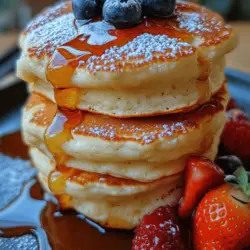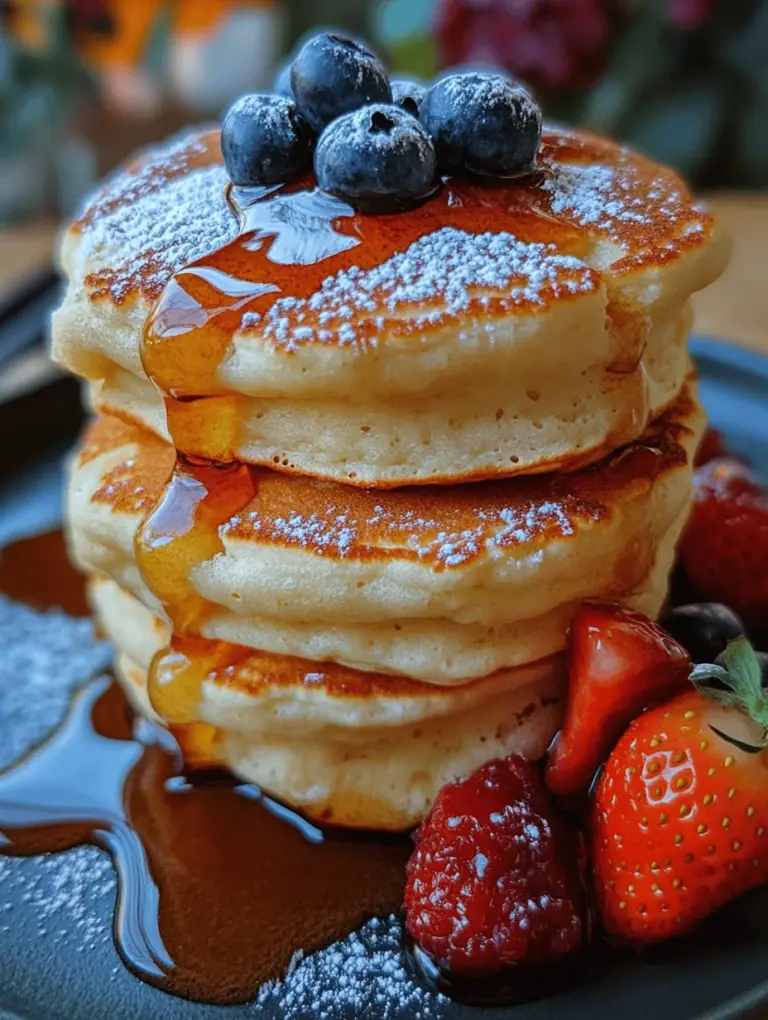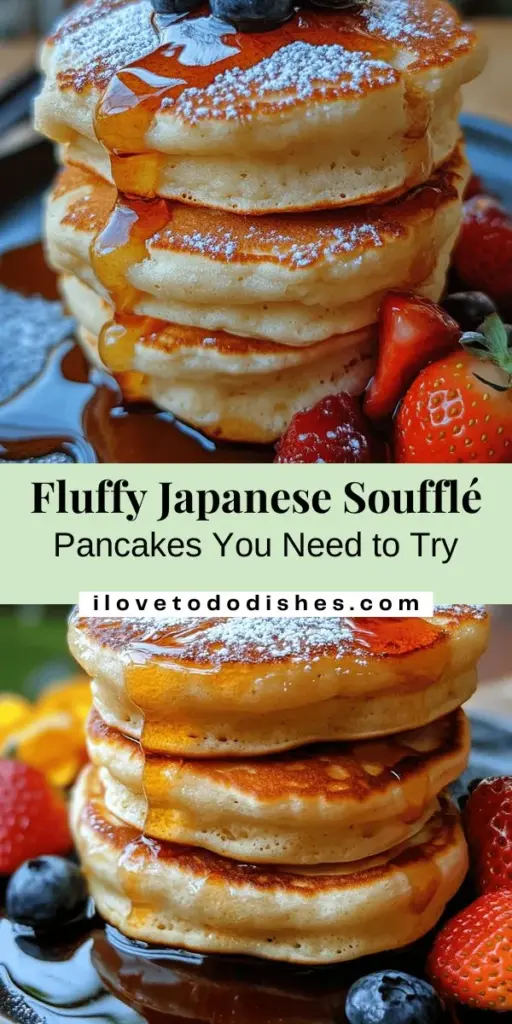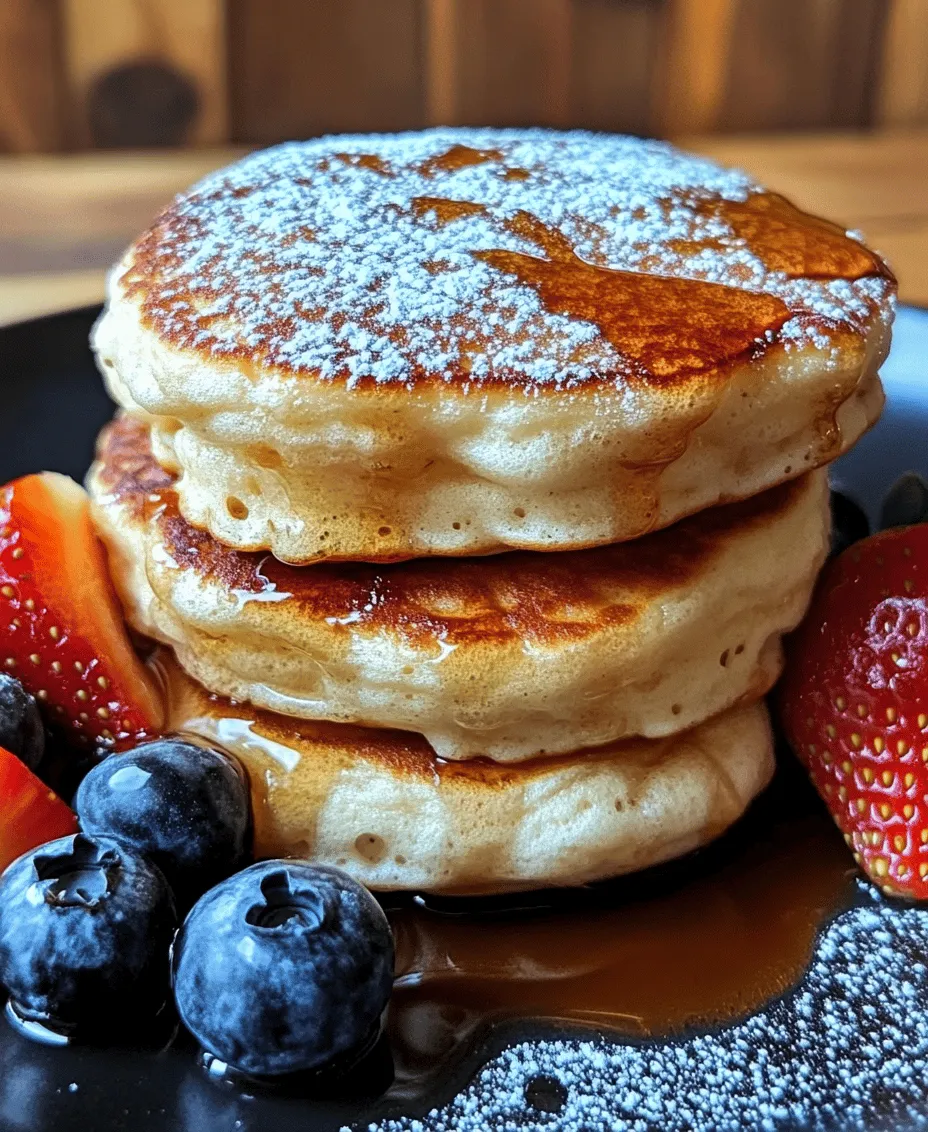Introduction
Fluffy Japanese soufflé pancakes have taken the culinary world by storm, captivating the hearts and taste buds of breakfast enthusiasts everywhere. These delightful creations are not your average pancakes—each bite is a soft, airy cloud of deliciousness that feels like a gentle embrace. The rising popularity of these pancakes can be attributed to their unique texture, which is a result of a delicate cooking process that transforms simple ingredients into a stunning visual and gastronomic experience. Whether you’re looking to impress guests at a brunch gathering or simply wanting to treat yourself to a luxurious breakfast, these pancakes are a must-try.
What sets Japanese soufflé pancakes apart from traditional pancakes is their remarkable height and fluffiness. Unlike the dense, flat counterparts that many are familiar with, soufflé pancakes rise majestically as they cook, creating a light and airy treat that seems almost ethereal. This unique texture is achieved through a combination of whipped egg whites and careful cooking techniques, making them not just a meal, but an experience to savor.
In addition to their impressive appearance and texture, these pancakes are incredibly versatile. They can be enjoyed plain or topped with a variety of delicious accompaniments, such as maple syrup, fresh fruits, whipped cream, or even a dusting of powdered sugar. The balance of flavors and textures makes them perfect for any time of day, but they truly shine during breakfast or brunch occasions, where they can be the star of the table.
Understanding Japanese Soufflé Pancakes
Historical Background of Soufflé Pancakes
The origins of Japanese soufflé pancakes can be traced back to the fusion of Western culinary techniques with traditional Japanese cuisine. In the early 2000s, chefs began experimenting with pancake recipes, incorporating the lightness of soufflé dishes into the classic pancake format. This innovation quickly gained traction, particularly in cafés and trendy eateries in Japan, where visually stunning dishes are highly sought after. As social media platforms like Instagram began showcasing these fluffy delights, their popularity exploded beyond Japan, leading to a global phenomenon.
Japanese soufflé pancakes are often enjoyed as part of a leisurely brunch, where the experience of making and eating them becomes a cherished ritual. The careful preparation and presentation of these pancakes highlight the Japanese philosophy of “omotenashi,” or hospitality, where the act of serving food is as important as the food itself.
Comparison with Traditional Pancakes
When comparing Japanese soufflé pancakes to traditional pancakes, the differences are striking. Traditional pancakes are typically made from a simple batter of flour, milk, eggs, and baking powder, cooked on a griddle until golden brown. They tend to have a denser texture and a more straightforward flavor profile.
In contrast, Japanese soufflé pancakes require a more intricate process that involves separating the eggs, whisking the egg whites to stiff peaks, and gently folding them into the batter. This technique is crucial for achieving the signature fluffiness that defines these pancakes. The result is a pancake that is not only taller but also has a unique taste and texture that feels almost like a dessert rather than a breakfast item.
The Science Behind the Fluffy Texture
The key to the light and airy texture of Japanese soufflé pancakes lies in the science of cooking. The process begins with the separation of egg yolks and whites. The egg whites are whipped until they form stiff peaks, incorporating air into the mixture. This air is what gives the pancakes their rise and fluffy consistency.
Additionally, ingredients like cornstarch and baking powder play a significant role in the batter’s structure. Cornstarch lightens the mixture, while baking powder provides the necessary leavening to help the pancakes rise during cooking. When heated, the moisture in the batter turns into steam, causing the pancakes to puff up. This delicate balance of ingredients and techniques results in a texture that is both soft and substantial, making each bite a delightful experience.
Ingredients Breakdown
To create the perfect Japanese soufflé pancakes, it is essential to understand the purpose of each ingredient. Here’s a breakdown of what you’ll need:
All-Purpose Flour
All-purpose flour is the foundation of the pancake batter. It provides the necessary structure while maintaining a light texture. Using the right amount of flour is crucial; too little will result in flat pancakes, while too much can make them dense.
Cornstarch
Cornstarch is an essential ingredient for achieving the desired lightness. It helps to bind the ingredients while also contributing to that signature fluffy texture. By replacing a portion of the all-purpose flour with cornstarch, you’re allowing the pancakes to rise better during cooking.
Baking Powder
Baking powder acts as a leavening agent, helping the pancakes to rise and become airy. It’s important to use fresh baking powder to ensure the best results; old or expired baking powder can lead to flat pancakes.
Eggs
Eggs are critical in this recipe—not only do they provide moisture and flavor, but separating the yolks and whites allows for maximum fluffiness. The yolks are mixed with the other wet ingredients, while the egg whites are whipped separately to create the necessary structure and texture.
Milk and Vanilla Extract
Milk adds moisture to the batter, while vanilla extract enhances the flavor profile. Using whole milk is recommended for a richer taste, but you can substitute with any milk of your choice.
Sugar
Sugar is essential for balancing the flavors of the pancakes. It not only sweetens the batter but also contributes to the browning process during cooking, resulting in a beautiful golden crust.
Salt
Even a small amount of salt enhances the overall flavor of the pancakes. It helps to balance the sweetness and brings out the individual flavors of the other ingredients.
Optional Toppings
While the pancakes are delicious on their own, you can elevate them further with a variety of toppings. Consider serving them with warm maple syrup, fresh fruits like strawberries or blueberries, whipped cream, or a sprinkle of powdered sugar. The addition of toppings can create a beautiful presentation and enhance the flavor experience.
Step-by-Step Instructions
Prepping the Ingredients
Before diving into mixing the batter, it’s important to prepare your ingredients properly. Start by gathering all your ingredients and measuring them out carefully. This ensures that you have everything you need on hand and helps streamline the cooking process.
Sifting the all-purpose flour and cornstarch together is a crucial step that should not be overlooked. Sifting aerates the flour, breaking up any clumps and making it lighter, which contributes to the fluffiness of the pancakes. Additionally, sift the baking powder with the flour to ensure an even distribution throughout the batter.
Mixing the Batter
Begin by separating the egg yolks from the egg whites. In a mixing bowl, whisk together the egg yolks, milk, and vanilla extract until well combined. Next, add the sifted flour, cornstarch, baking powder, sugar, and salt to the wet mixture. Use a spatula or whisk to combine the ingredients gently, being careful not to overmix. The batter should be slightly lumpy, which is perfectly fine.
In a separate bowl, whip the egg whites until they reach stiff peaks. This is where the magic happens—this process incorporates air, which is essential for the soufflé effect. Once the egg whites are ready, use a spatula to fold them into the batter. Begin by adding a small portion of the whipped egg whites to lighten the mixture, then gently fold in the remaining whites. The goal is to maintain as much air as possible, which will help the pancakes rise beautifully during cooking.
With the batter mixed and ready, you’re just a few steps away from enjoying these delightful pancakes. Stay tuned for the next part, where we will cover the cooking process and tips for achieving the perfect soufflé pancakes.
Whipping Egg Whites: Techniques for Achieving Soft and Stiff Peaks
One of the most critical steps in making fluffy Japanese soufflé pancakes is whipping the egg whites. This process is essential for incorporating air into the batter, which is what gives the pancakes their signature height and airy texture. Here’s how to achieve both soft and stiff peaks effectively:
1. Choose the Right Equipment: Use a clean metal or glass bowl for whipping egg whites. Plastic bowls can retain grease, which will prevent the egg whites from whipping properly. A hand mixer or stand mixer with a whisk attachment works best for achieving the right consistency.
2. Temperature Matters: Egg whites whip better when at room temperature. Separate the eggs while they are cold and allow them to sit for about 30 minutes before whipping.
3. Soft Peaks: Begin whipping the egg whites on medium speed. After a few minutes, you should see the mixture become frothy. At this stage, you’re looking for soft peaks, where the peaks gently fold over when the whisk is lifted. This is the perfect consistency to start adding sugar.
4. Stiff Peaks: Gradually add granulated sugar (or powdered sugar for a finer texture) while continuing to whip the egg whites on high speed. Continue until you achieve stiff peaks; when you lift the whisk, the peaks should stand straight up without collapsing.
Folding Techniques: How to Properly Fold Egg Whites into the Batter Without Deflating
Once your egg whites are whipped to perfection, the next step is to carefully incorporate them into the batter. Folding is a technique that helps maintain the airiness of the whipped egg whites. Here’s how to do it right:
1. Use a Rubber Spatula: A rubber spatula is ideal for folding as it allows for gentle mixing without deflating the egg whites.
2. Add a Portion of the Egg Whites: Start by adding a small portion of the whipped egg whites to the batter. This helps lighten the batter and makes it easier to fold in the remaining egg whites.
3. Fold Gently: With the spatula, cut through the center of the batter, scrape along the bottom, and lift it over the egg whites. Rotate the bowl slightly with each fold to ensure even mixing. Be gentle and avoid stirring; the goal is to keep as much air in the egg whites as possible.
4. Repeat: Continue folding in the egg whites until just combined. It’s okay if you see a few streaks of egg whites—overmixing can lead to denser pancakes.
Cooking Method: Tips for Controlling Temperature and Achieving the Perfect Brown
The cooking method is crucial for achieving that desirable soft and fluffy texture. Here are some tips to help you get it just right:
1. Preheat Your Skillet: Use a nonstick skillet or griddle and preheat it over low to medium-low heat. This temperature is vital, as it allows the pancakes to cook through without burning the outside.
2. Use Cooking Rings: If you have them, use cooking rings to help the pancakes maintain their shape and height. If you don’t have cooking rings, you can create makeshift ones using aluminum foil or even use muffin rings.
3. Control the Heat: Once you pour the batter into the skillet (about 1/4 cup for each pancake), cover the skillet with a lid. This traps steam and helps the pancakes rise. Cook for about 4-5 minutes until the bottom is golden brown.
4. Flipping the Pancakes: Carefully remove the cooking rings and flip the pancakes. Cover again and cook for an additional 3-4 minutes. The key is to avoid high heat, which can lead to burnt outsides and raw insides.
Serving Suggestions: Ideas for Plating and Garnishing the Pancakes
Presentation plays a significant role in enjoying your soufflé pancakes. Here are some serving suggestions to elevate your dish:
1. Stacking: Serve the pancakes in a tall stack, which enhances their impressive height. Consider layering them with a dollop of whipped cream or a layer of fruits like fresh berries or banana slices.
2. Garnish: Drizzle maple syrup or honey over the pancakes for added sweetness. You can also sprinkle powdered sugar on top for a refined look.
3. Fruits and Nuts: Fresh fruits like strawberries, blueberries, or mango slices add color and complement the pancakes’ flavor. For a crunchy texture, consider topping with crushed nuts such as almonds or walnuts.
4. Flavored Syrups: Experiment with flavored syrups, such as matcha or lavender, to add a unique twist to your pancakes.
Cooking Tips for Perfect Soufflé Pancakes
Creating the perfect soufflé pancakes can be challenging, but with these tips, you will have a better chance of achieving fluffy success:
1. Choosing the Right Skillet: A nonstick skillet is recommended for cooking soufflé pancakes. It prevents sticking and allows for easy flipping. If you don’t have a nonstick option, be sure to use plenty of oil or butter.
2. Temperature Control: Cooking pancakes over low heat is crucial. This allows the insides to cook through while the outsides become perfectly golden. If the heat is too high, you risk burning the pancakes before they have a chance to rise.
3. Alternatives to Cooking Rings: If you don’t have cooking rings, you can use muffin tins or even make your own with aluminum foil. Just ensure they are sturdy enough to hold the batter.
4. Troubleshooting Common Issues: If your pancakes don’t rise, it could be due to overmixing the batter or not whipping the egg whites enough. If they are cooking unevenly, check your heat settings—lower the temperature and give them more time.
Nutritional Information
Understanding the nutritional content of your pancakes can help you make informed choices. Here’s a breakdown of the calories and macronutrients per serving (two pancakes):
– Calories: Approximately 250-300 calories
– Protein: 8-10 grams
– Carbohydrates: 35-40 grams
– Fat: 8-10 grams
Health Aspects of Ingredients Used
The ingredients in soufflé pancakes can have health benefits. For instance, eggs provide essential proteins and nutrients, while whole grain flour can offer more fiber than all-purpose flour.
Suggestions for Healthier Ingredient Substitutions
If you’re looking to make the pancakes a bit healthier, consider these substitutions:
– Whole Grain Flour: Use whole wheat flour instead of all-purpose flour for added fiber.
– Natural Sweeteners: Replace granulated sugar with honey or maple syrup to reduce refined sugars.
– Dairy Alternatives: If you want to make it dairy-free, consider using almond milk or coconut milk instead of regular milk.
Cultural Significance and Trends
Fluffy Japanese soufflé pancakes have surged in popularity across the globe, especially on social media platforms. Their unique texture and aesthetic appeal make them highly shareable, leading to their rise in cafes and restaurants worldwide.
1. The Rise of Soufflé Pancakes: Originating in Japan, these pancakes have become a staple in various brunch menus around the world. Their light, airy texture sets them apart from traditional pancakes, making them a favored choice for those seeking a unique breakfast experience.
2. Social Media Influence: Platforms like Instagram have played a significant role in popularizing soufflé pancakes. Food influencers showcase their fluffy creations, enticing viewers with their visual appeal and flavor, inspiring many to recreate them at home.
3. Variations Around the World: While the traditional Japanese version is fluffy and light, different cultures have put their spin on soufflé pancakes. From adding matcha in Japan to creating savory versions in Korea, these pancakes continue to evolve while retaining their core characteristics.
Conclusion
Making fluffy Japanese soufflé pancakes is not just about the end product but the delightful experience involved in the cooking process. From mastering the art of whipping egg whites to carefully folding them into the batter, every step is a learning opportunity.
The joy of serving and sharing these pancakes with family and friends makes it a special breakfast or brunch experience. So, gather your ingredients and try this unique recipe at home. You’ll not only enjoy the delicious taste but also the satisfaction of creating something beautiful and fluffy. Cooking is a celebration, and these pancakes are the perfect way to bring loved ones together around the table.



